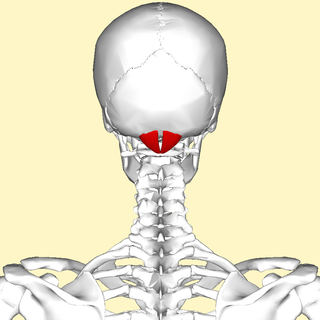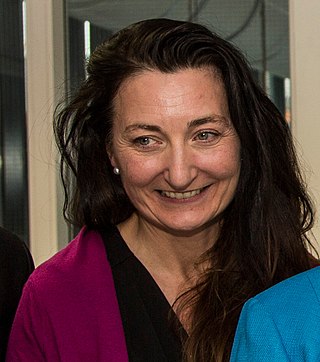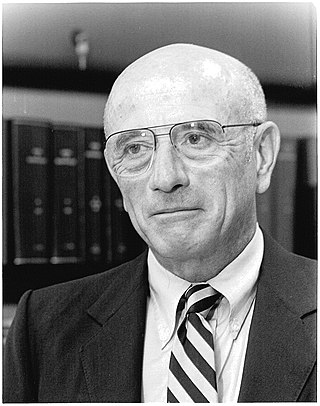Related Research Articles

Ivan Petrovich Pavlov was a Russian and Soviet experimental neurologist and physiologist known for his discovery of classical conditioning through his experiments with dogs.

The neck is the part of the body on many vertebrates that connects the head with the torso. The neck supports the weight of the head and protects the nerves that carry sensory and motor information from the brain down to the rest of the body. In addition, the neck is highly flexible and allows the head to turn and flex in all directions. The structures of the human neck are anatomically grouped into four compartments; vertebral, visceral and two vascular compartments. Within these compartments, the neck houses the cervical vertebrae and cervical part of the spinal cord, upper parts of the respiratory and digestive tracts, endocrine glands, nerves, arteries and veins. Muscles of the neck are described separately from the compartments. They bound the neck triangles.

Eric Richard Kandel is an Austrian-born American medical doctor who specialized in psychiatry, a neuroscientist and a professor of biochemistry and biophysics at the College of Physicians and Surgeons at Columbia University. He was a recipient of the 2000 Nobel Prize in Physiology or Medicine for his research on the physiological basis of memory storage in neurons. He shared the prize with Arvid Carlsson and Paul Greengard.

The grey column refers to a somewhat ridge-shaped mass of grey matter in the spinal cord. This presents as three columns: the anterior grey column, the posterior grey column, and the lateral grey column, all of which are visible in cross-section of the spinal cord.

The reticular formation is a set of interconnected nuclei that are located throughout the brainstem. It is not anatomically well defined, because it includes neurons located in different parts of the brain. The neurons of the reticular formation make up a complex set of networks in the core of the brainstem that extend from the upper part of the midbrain to the lower part of the medulla oblongata. The reticular formation includes ascending pathways to the cortex in the ascending reticular activating system (ARAS) and descending pathways to the spinal cord via the reticulospinal tracts.

The rectus capitis posterior minor is a muscle in the upper back part of the neck. It is one of the suboccipital muscles. Its inferior attachment is at the posterior arch of atlas; its superior attachment is onto the occipital bone at and below the inferior nuchal line. The muscle is innervated by the suboccipital nerve. The muscle acts as a weak extensor of the head.

Carol Davila University of Medicine and Pharmacy or University of Medicine and Pharmacy Bucharest, commonly known by the abbreviation UMFCD, is a public health sciences university in Bucharest, Romania. It is one of the largest and oldest institutions of its kind in Romania. The university uses the facilities of over 20 clinical hospitals all over Bucharest.

The vestibulospinal tract is a neural tract in the central nervous system. Specifically, it is a component of the extrapyramidal system and is classified as a component of the medial pathway. Like other descending motor pathways, the vestibulospinal fibers of the tract relay information from nuclei to motor neurons. The vestibular nuclei receive information through the vestibulocochlear nerve about changes in the orientation of the head. The nuclei relay motor commands through the vestibulospinal tract. The function of these motor commands is to alter muscle tone, extend, and change the position of the limbs and head with the goal of supporting posture and maintaining balance of the body and head.

The Rexed laminae comprise a system of ten layers of grey matter (I–X), identified in the early 1950s by Bror Rexed to label portions of the grey columns of the spinal cord.

The spinal cord is a long, thin, tubular structure made up of nervous tissue, which extends from the medulla oblongata in the brainstem to the lumbar region of the vertebral column (backbone). The backbone encloses the central canal of the spinal cord, which contains cerebrospinal fluid. The brain and spinal cord together make up the central nervous system (CNS). In humans, the spinal cord begins at the occipital bone, passing through the foramen magnum and then enters the spinal canal at the beginning of the cervical vertebrae. The spinal cord extends down to between the first and second lumbar vertebrae, where it ends. The enclosing bony vertebral column protects the relatively shorter spinal cord. It is around 45 cm (18 in) long in adult men and around 43 cm (17 in) long in adult women. The diameter of the spinal cord ranges from 13 mm in the cervical and lumbar regions to 6.4 mm in the thoracic area.

May-Britt Moser is a Norwegian psychologist and neuroscientist, who is a Professor of Psychology and Neuroscience at the Norwegian University of Science and Technology (NTNU). She and her then-husband, Edvard Moser, shared half of the 2014 Nobel Prize in Physiology or Medicine, awarded for work concerning the grid cells in the entorhinal cortex, as well as several additional space-representing cell types in the same circuit that make up the positioning system in the brain. Together with Edvard Moser she established the Moser research environment at NTNU, which they lead. Since 2012 she has headed the Centre for Neural Computation.

Jeffrey Todd Laitman is an American anatomist and physical anthropologist whose science has combined experimental, comparative, and paleontological studies to understand the development and evolution of the human upper respiratory and vocal tract regions. He is a Distinguished Professor of the Icahn School of Medicine at Mount Sinai in New York City where he holds other positions, including Professor and Director of the Center for Anatomy and Functional Morphology, Professor of Otolaryngology and Professor of Medical Education.

Shepherd Ivory Franz was an American psychologist. He was the first chairman of the psychology department at the University of California, Los Angeles and served as president of the American Psychological Association. Franz was the editor of multiple psychological journals and he contributed research to the concepts of neuroplasticity, afterimages and cerebral localization. He spent many years affiliated with George Washington University School of Medicine & Health Sciences and the Government Hospital for the Insane, later known as St. Elizabeth's Hospital.

Edward Roy Perl was an American neuroscientist whose research focused on neural mechanisms of and circuitry involved in somatic sensation, principally nociception. Work in his laboratory in the late 1960s established the existence of unique nociceptors. Perl was one of the founding members of the Society for Neuroscience and served as its first president. He was a Sarah Graham Kenan Professor of Cell Biology & Physiology and a member of the UNC Neuroscience Center at the University of North Carolina School of Medicine.
Adrian R. Morrison was the 1991 AAAS Scientific Freedom and Responsibility Award recipient.

Russell L. De Valois was an American scientist recognized for his pioneering research on spatial and color vision.

Jessica Barson is an American neuroscientist and associate professor at Drexel University College of Medicine. Barson investigates neuropeptide signalling in the paraventricular nucleus of the thalamus as well as the nucleus accumbens to understand the neurobiological basis of addiction and elucidate targets for therapy.

National Pirogov Memorial Medical University, Vinnytsya is a medical university located in Vinnytsia, Ukraine. It was founded in 1921. Its predecessors were the Vinnytsia Pharmaceutical Institute (1921), the Vinnytsia Branch of the All-Ukrainian Institute of Correspondence Medical Education (1930), the Vinnytsia Evening Industrial Medical Institute (1932), the Vinnytsia Medical Institute (1934).

Nikolai Bogduk is a retired Australian anatomist, and emeritus professor of the University of Newcastle Bone & Joint Institute, Australia. His research and publications were primarily on the anatomical sources and causes of chronic spinal pain and headache, as well as the development of new diagnostic techniques and treatments for these conditions. He has made significant contributions to the field of spinal anatomy, biomechanics, as well as spinal pain diagnosis and management.
William Frederick Windle was an American anatomist and experimental neurologist.
References
- ↑ Craig, Arthur Dewitt (1978). "Anatomic and electrophysiologic studies on the lateral cervical nucleus in cat and dog" . Retrieved 2015-07-14.
- ↑ "Atkinson Pain Research Laboratory". Thebarrow.org. Retrieved 2015-07-14.
- ↑ "Frederick W. L. Kerr Basic Science Research Award". Americanpainsociety.org. Archived from the original on 2015-07-14. Retrieved 2015-07-14.